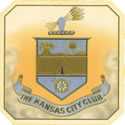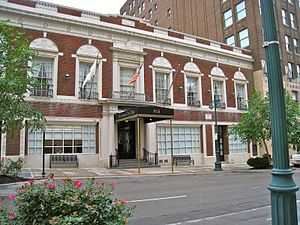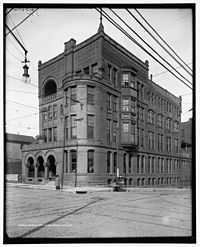Kansas City Club
 | |
| Private club | |
| Founded | Kansas City, Missouri, 1882 |
| Headquarters |
918 Baltimore Avenue Kansas City, Missouri 64105 |
| Website | www.thekansascityclub.com |
The Kansas City Club, founded in 1882 and located in the Library District of Downtown Kansas City, Missouri, USA, is the oldest existing gentlemen's club in Missouri. (The club began admitting women members in 1975.) Along with the River Club on nearby Quality Hill, it is one of two surviving private city clubs on the Missouri side of Kansas City. Notable members have included Presidents Harry Truman and Dwight D. Eisenhower, General Omar Bradley, and political boss Tom Pendergast.
Clubhouse

The club is located in a neoclassical masonry and reinforced concrete building at 918 Baltimore Avenue, which was designed by John McKecknie and built in 1922.[1] It is situated at the corner of Ninth Street across Baltimore Avenue from the Central Library and across Ninth Street from the New York Life Building. The clubhouse previously was home to the University Club of Kansas City from 1922 to 2001 (see below).
The four-story clubhouse contains a dining room, a pub, a library, a cigar stand, full-service athletic facilities, and banquet and meeting facilities including a lounge, a ballroom, and private conference rooms.[2] Two "inner clubs" have their own private lounge and bar spaces for their own members.[2] The athletic facilities include cardio, weight, and strength training equipment, a trainer, a masseuse, hot tubs, steam rooms, saunas, a racquetball court, and two squash courts.[2] Along with the University of Missouri-Kansas City and the Pembroke Hill School, the Kansas City Club is one of only three locations in Kansas City with squash facilities.[3]
History

In the period after the Civil War, most of Kansas City’s existing social clubs were pro-Confederate.[4] A group of prominent local businessmen and professionals, including Edward H. Allen, Victor B. Bell, Alden J. Blethen, Thomas B. Bullene, Gardiner Lathrop, August Meyer, Leander J. Talbott, William Warner, and Robert T. Van Horn, decided to provide an alternative, and organized the Kansas City Club on November 10, 1882.[4] Initially, the club met at Kersey Coates's hotel on Quality Hill.[4] In 1888, the club moved into its first clubhouse, a brick building at the corner of Twelfth and Wyandotte Streets.[4]

In 1922, having absorbed several other clubs, and with a membership of more than 600, the club built a 14-story beaux arts clubhouse (the Kansas City Club Building) at the corner of Thirteenth Street and Baltimore Avenue, designed by local architect, Charles A. Smith.[4] The clubhouse included a large dining room, several bars, private meeting rooms, a banquet hall, athletic facilities, an indoor pool, six floors of guestrooms, and a rooftop terrace.[4] The club quickly grew and entered into reciprocal arrangements with many other prominent clubs worldwide.[4] Membership was opened to women in 1975.[4]
In 1987, the club had 2,180 members.[5] By 2001, however, membership had dwindled to less than 900.[5] The club blamed the drop in membership on the Tax Reform Act of 1986, which made private club dues non-deductible, as well as changes in culture that made young professionals less apt to join clubs.[6] The clubhouse also needed upgrades to its facilities that cost between $5 million and $10 million.[5]
Finally, effective July 31, 2001, the club agreed to merge with the University Club, a 100-year-old gentlemen's club at the corner of Ninth Street and Baltimore Avenue, and purchase the University Club's facilities, which were smaller and cost only $1 million to upgrade.[5] The merger also infused the Kansas City Club with the University Club's 200-person membership.[5] In 2002, a developer bought the Kansas City Club's 1922 building and turned it into loft apartments and a banquet hall, renaming it the "Clubhouse on Baltimore."[7]
Since 2010, the club has lent space to Washington University in St. Louis's Olin School of Business local "Executive MBA" program.[8][9] In November 2012, the club celebrated its 130th anniversary with a charity gala.[10]
In popular culture
- On the eighth episode of the third season (2012) of HBO's series Boardwalk Empire, titled "The Pony", Nucky Thompson poses as a member of the Kansas City Club in order to gain access to the Union Club of the City of New York via "a reciprocal agreement" between the two clubs.
Notable members
- Edward H. Allen, 10th Mayor of Kansas City (1867–68)[4]
- Victor B. Bell, lumber magnate[4]
- Richard L. Berkley, 50th Mayor of Kansas City (1979–91)[4]
- Alden J. Blethen, newspaper publisher[4]
- Pasco Bowman, judge, United States Court of Appeals for the Eighth Circuit (1983-2003)[4]
- Omar Bradley, senior U.S. Army field commander in North Africa and Europe during World War II[4]
- Thomas B. Bullene, owner of the Emery, Bird, Thayer Dry Goods Company, 22nd Mayor of Kansas City (1882–83)[4]
- Kersey Coates, early Kansas City hotel magnate[4]
- Harry Darby, U.S. Senator from Kansas (1949–50)[4]
- Dwight D. Eisenhower, 34th President of the United States (1953–61)[4]
- John B. Gage, 45th Mayor of Kansas City (1940–46)[4]
- Ewing Kauffman, pharmaceutical magnate and owner of the Kansas City Royals[4]
- Charles E. Kearney, early railroad magnate[4]
- R. Crosby Kemper, banker and philanthropist[4]
- R. Crosby Kemper Jr., banker and philanthropist[4]
- Gardiner Lathrop, attorney[4]
- Robert A. Long, lumber magnate[11]
- August Meyer, mining magnate[4]
- Ralph Leroy Nafziger, founder of Hostess Brands[12]
- Tom Pendergast, Democratic Party political boss[4]
- Charles H. Price II, businessman, U.S. Ambassador to Belgium (1981–83), U.S. Ambassador to the United Kingdom (1983–89)[4]
- James A. Reed, U.S. Senator from Missouri (1911–29), 32nd Mayor of Kansas City (1900–04)[13]
- Jack Steadman, Kansas City Chiefs general manager (1966–76), president (1976–89), chairman (1989-2005), and vice-chairman (2005–07)[4]
- Leander J. Talbott, realtor and politician, 24th Mayor of Kansas City (1884–85)[4]
- Joseph P. Teasdale, 48th Governor of Missouri (1977–81)[4]
- Harry S. Truman, 33rd President of the United States (1945–53), 34th Vice President of the United States (1945), U.S. Senator from Missouri (1935–45)[4]
- Robert T. Van Horn, lawyer, U.S. Representative from Missouri (1865–71), 6th Mayor of Kansas City (1861–62, 1863–65)[4]
- William Warner, lawyer, U.S. Senator from Missouri (1905–11), U.S. Representative from Missouri (1885–89), 13th Mayor of Kansas City (1871–72)[4]
- William L. Webster, 39th Missouri Attorney General (1985–93)
- Charles Evans Whittaker, Associate Justice of the Supreme Court of the United States (1957–62)[4]
- David Wysong, Kansas politician[4]
See also
- List of American gentlemen's clubs
- Kansas City Athletic Club
- Kansas City Country Club
- Missouri Athletic Club
References
- ↑ "Library District Walking Tour," Kansas City Library (retrieved Aug. 5, 2013)
- ↑ 2.0 2.1 2.2 The Kansas City Club (Official Website)
- ↑ United States Squash Racquets Association: Missouri facility locations
- ↑ 4.0 4.1 4.2 4.3 4.4 4.5 4.6 4.7 4.8 4.9 4.10 4.11 4.12 4.13 4.14 4.15 4.16 4.17 4.18 4.19 4.20 4.21 4.22 4.23 4.24 4.25 4.26 4.27 4.28 4.29 4.30 4.31 4.32 4.33 4.34 Jerry T. Duggan, A History of the Kansas City Club: 1882-1982 (The Kansas City Club: 1982)
- ↑ 5.0 5.1 5.2 5.3 5.4 Katie Hollar, "Kansas City Club, University Club will merge," Kansas City Business Journal (July 25, 2001)
- ↑ Leslie Zganjar, "Kansas City Club has 30 days to decide, University Club president says," Kansas City Business Journal (May 25, 2001)
- ↑ Rob Roberts, "Owners will convert Gumbel Building into condominiums," Kansas City Business Journal (May 8, 2005)
- ↑ "Executive MBA Kansas City Program Launched by Olin Business School at Washington University in St. Louis," PRWeb.com (Mar. 13, 2010)
- ↑ "Executive MBA: Locations," Washington University in St. Louis Olin School of Business (retrieved Aug. 8, 2013)
- ↑ "Kansas City Club 130th Anniversary Celebration," Kansas City Independent (November 2012)
- ↑ William E. Connelley, A Standard History of Kansas and Kansans (Chicago: Lewis, 1918)
- ↑ George Derby and James Terry White, The National Cyclopedia of American Biography (2012 ed.)
- ↑ "James Alexander Reed (1861-1944) Papers," University of Missouri-Kansas City Western Historical Manuscript Collection (retrieved Aug. 9, 2013)
External links
Coordinates: 39°06′11″N 94°35′04″W / 39.102931°N 94.584405°W